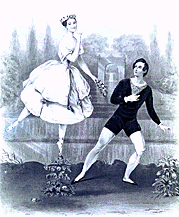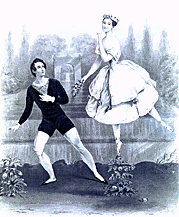
Discussion

Through my artifact
analysis of pointe shoes and my preliminary research, I’ve developed
interests in a few different areas. These areas include England and France
in the Nineteenth century, gender relations, and conventional notions
of the ballet dancer. My initial readings have led me to believe that
these different areas of concern come together in the pointe shoe. I wish
to reiterate that the selection of readings provided in the annotated
bibliography represent my preliminary efforts and will need to be augmented
in order to address the issues generated by my analysis completely.
The Nineteenth century has always held a particular interest for me. From
my initial foray into the literature directly and indirectly related to
pointe shoes, I discovered that pointe shoes appeared early in that century.
While it’s hard to pinpoint exactly when, it seems safe to reason
that they arrived on stage in the dance world sometime during the eighteen-twenties
in Paris and/or London. However, the pursuit of dancing on one’s
toes had come into play a few decades before this time. While dancing
en pointe was common throughout the Nineteenth-century, it appears that
these shoes did not become available on the mass market until the eighteen-eighties.
I plan on examine this period to see if I can discover anything about
the social environment in which this type of ballet made possible by pointe
shoes was popularized. Did the social and political atmosphere create
a need or desire that called for the development of pointe shoes? The
greatest concentration of information around the arrival of pointe work
seems to centre on England and France. These two nations seemed to constitute
the greatest consumers of ballet, and the arts in general, during this
time. More research will be required in this area before I can make any
specific claims about the social climate of these countries during the
Nineteenth century.
The use of pointe shoes seems to lead naturally to questions regarding
notions of gender, due to the fact that the use of these objects seems
to fall entirely to women. Women seem to have achieved a prominent role
in the dance world almost simultaneously with the arrival of the pointe
shoe. The role of men on stage, on the other hand, was reduced to being
a porter or support for the ballerina. Many prominent male dancers took
on the tasks of instructor and choreographer as they were displaced from
public performances. All of this may underscore other shifts that were
going on within the greater social realm of France and England. A great
deal of work has been done on this topic, especially in relation to the
Nineteenth century. My subsequent research will focus on exploring how
point shoes underscore and undermine prescribed notions of gender during
this time.
The image of the ballet dancer is intimately tied with pointe shoes in
contemporary society. I am interested in discovering how this conflation,
and its relationship to women, effected dance. Primarily performed by
men during the eighteenth-century, ballet in the nineteenth century centered
on the ballerina. I wish to find out what role pointe shoes played in
this shift from male- to female-centered dancing. As well, it would be
interesting to explore if this shift changed the way dance was regarded
and consumed, and if so, how. For this exploration, I will have to investigate
how dance shoes looked before the advent of the pointe shoe.
One direction that I have not explored yet in regards to pointe shoes
is the relationship with foot-binding. This may provide an interesting
comparison, especially considering the nineteenth-century European fascination
with the “Orient” and Japanese and Chinese arts. I will have
to locate literature on this practice to determine whether or not it will
provide new insights into my object.
I believe the pointe shoe forms the crux of many of these concerns. As
McCracken suggests, objects are often entrusted to communicate messages
that are too volatile for explicit language. Nineteenth-century France
and England had particular expectations in regards to appropriate gender
roles and I believe that these notions were conveyed by many of the objects
of that time. By looking at pointe shoes, I hope to arrive at an idea
of what it would have meant to be a ballerina during this time and how
these shoes registered that meaning to society as well as how the individual
was able to define herself through these objects.
| Motivating Questions | Discussion
& Proposed Research Strategy |